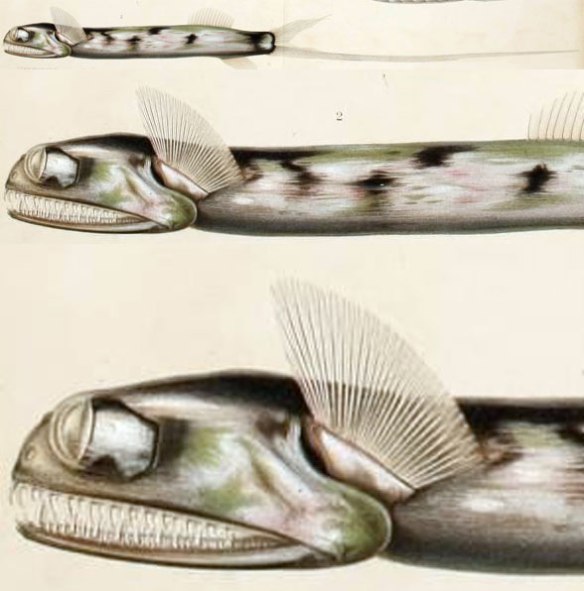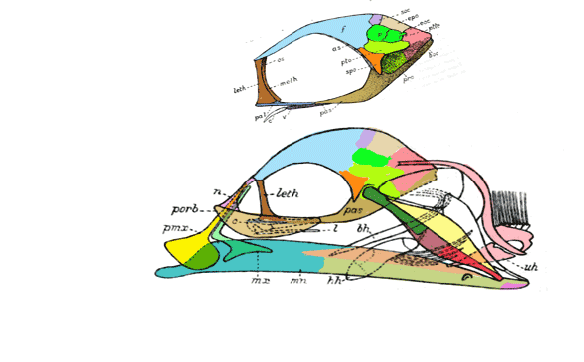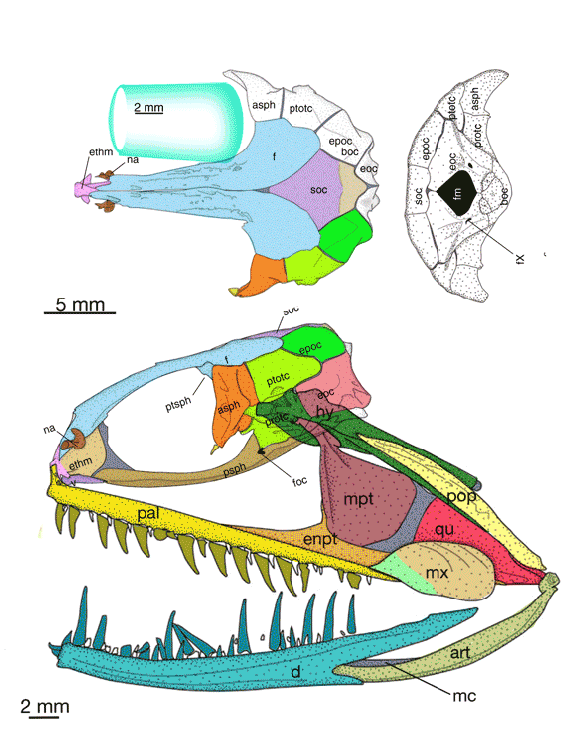Stylephorus chordatus
(originally Stylophorus chordatus (Shaw 1791, Regan 1924) is an elongate, oceanic fish rarely encountered either in the sea or in the library.

Figure 1. Stylephorus ontogeny and feeding
According to Wikipedia
“The tube-eye or thread-tail, Stylephorus chordatus, is a deep-sea fish, the only fish in the genus Stylephorus and family Stylephoridae.”
“It is found in deep subtropical and tropical waters around the world, living at depths during the day and making nightly vertical migrations to feed on plankton. It is an extremely elongated fish; although its body grows only to 28 cm (11 in) long, its pair of tail fin rays triple its length to about 90 cm (35 in). Its eyes are tubular in shape, resembling a pair of binoculars”
“It has a tubular mouth through which it sucks seawater by enlarging its oral cavity to about 40 times its original size. It then expels the water through the gills, leaving behind the copepods on which it feeds.”
Traditionally and due to taxon exclusion,
Stylephorus has been nested within the traditional clade Lampriformes (Fig. 2). In the large reptile tree (LRT, 1789+ taxa) members nest in at least three clades.

Figure 2. Traditional Lampriformes now distributed elsewhere in the LRT. White taxa have not yet been tested.
As in the telescope fish,
Gigantura (Figs. 2, 4), the eyes of Stylephorus are also elongate. The length of Stylephorus sans tail measures 10 to 11 inches. The tail extends this another 22 to 35 inches. Regan 1924 described Stylephorus from a one and only juvenile specimen (Fig. 1).

Figure 3. Gigantura indica overall. Note the pectoral fins above the gill openings and lack of pectoral fins.
From the Regan 1924 abstract
“The fish known as Stylophorus chordatus was first described in 1791 by Shaw from a specimen taken swimming at the surface between the islands of Cuba and Martinique. For more than a hundred years this was the only example known. It was preserved in the Museum of the Royal College of Surgeons, where it was examined by several ichthyologists, including Günther, who placed Stylophorus in the Trachypteridae (see below). In 1887 the specimen was transferred to the Natural History Museum; at some time or other it had been hacked about by an enthusiastic anatomist, so that in 1907, in a memoir on the anatomy and classification of the Allotriognathi, I wrote, “The remarkable Stylophorus has usually been placed with or near the Trachypteridae. The single known specimen is not in good enough condition for me to offer any suggestion as to its relationships.”
Trachypteridae are ribbon fish, characterized by “a long, compressed, tape-like body, short head, narrow mouth and feeble teeth”. Other traditional clade members include Zu cristatus, Trachipterus, and Desmodema (but see figure 2).

Figure 4. Stylophorus skull showing the extruding jaws, completely different from those of Gigantura, figure 4.
Miya et al. 2007 tested the DNA of the tube-eye. They wrote:
“The rare, monotypic deep-sea fish family Stylephoridae has long been considered a member of the order Lampridiformes (opahs, velifers, ribbonfishes), and no systematic ichthyologist has questioned its placement within the order for over 80 years… The resulting trees derived from partitioned Bayesian analyses strongly indicated that S. chordatus is not a lampridiform but is closely related to the order Gadiformes (cod and their relatives). Considering its unique morphologies with no indication of affinities within Gadiformes (or any other presently recognized order), the present results warrant a recognition of the new order for S. chordatus in fish systematics.”
In the LRT Stylephorus was tested against Gadus the Atlantic codfish (newly added, soon to be posted) and all other fish, including oarfish. Stylephorus nested with Gigantura.

Figure 5. Gigantura skull tracings from Konstantinidis and Johnson 2016. Colors added.
Mooi and Gill 2010 wrote
“We contend that the move away from providing character evidence with phylogenies has diminished fish systematics and systematics in general, and amounts to a crisis.”
“The role of morphological characters has largely been reduced to their optimization and reinterpretation on the revealed “truth” of molecule-based topologies. All of this has resulted in a schism between molecular and morphological phylogeneticists.”
“We feel that phylogenetics can only move forward by recognizing that molecules are small-scale morphology; molecular data are not substantively different from larger-scale morphological data and should be treated in much the same manner. “
“Careful investigation of homology and transparent presentation of evidence will keep our work and our science relevant. “
Apparently no one has tested Gigantura
( Figs. 3, 5, but see below). A wide gamut phylogenetic analysis always resolves and recovers relationships and weeds out convergence. On the other hand, taxon exclusion always leads to confusion.
Deleting Gigantura in the LRT
nests Stylelphorus between sticklebacks and sea horses (likely due to similar mouth parts), not far from oarfish (Regalecus). That’s why Stylephorus has been considered close to oarfish. In the LRT it is an oarfish mimic.
This is NOT a novel hypothesis of interrelationships.
Long before the pre-cladistic era, Brauer (1901) compared Gigantura with Stylephorus because of their superficial resemblance (e.g. both species have anteriorly directed tubular eyes, silvery coloration, and elongated caudal fin rays). Let’s see if other workers add Gigantura to future Stylephorus analyses.
References
Brauer A 1901. Über einige von der Valdivia-Expedition gesammelte Tiefseefische und ihre Augen. Sitzungsberichte der Gesellschaft zur Beförderung der Gesamten Naturwissenschaften zu Marburg 8: 115–130.
Miya, M. et al. (11 co-authors) 2007. Mitochondrial genome and a nuclear gene indicate a novel phylogenetic position of deep-sea tube-eye fish (Stylephoridae). Ichthyological Research. 54 (4): 323–332.
Mooi RD and Gill AC 2010. Phylogenies without Synapomorphies—A Crisis in Fish Systematics: Time to Show Some Character. Zootaxa 2450:26–40.
Regan CT 1924. The morphology of the rare oceanic fish, Stylophorus chordatus, Shaw; based on specimens collected in the Atlantic by the “Dana” expeditions, 1920–1922. Proceedings of the Royal Society B 96(674): PDF
Shaw G 1791. Description of the Stylephorus chordatus, a new fish. Transactions of the Linnean Society of London, 2d Ser: Zoology 1:90–92.
